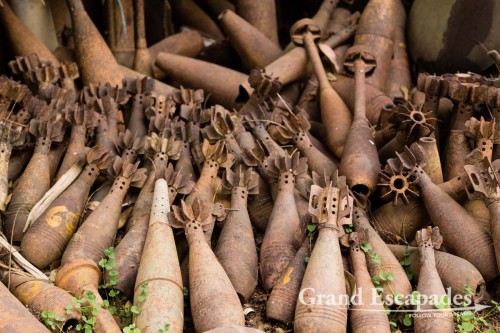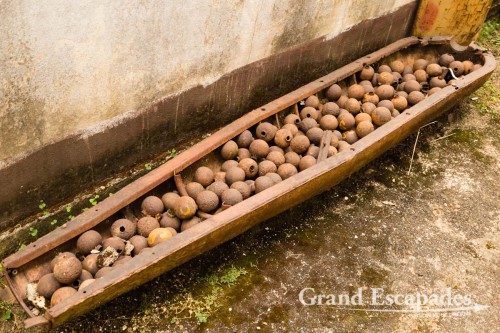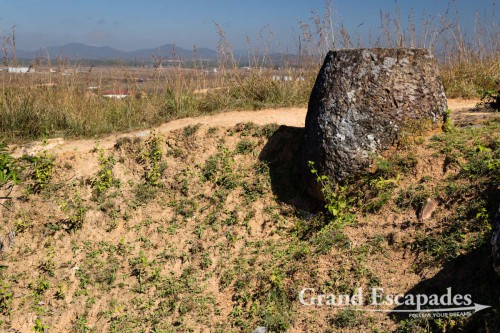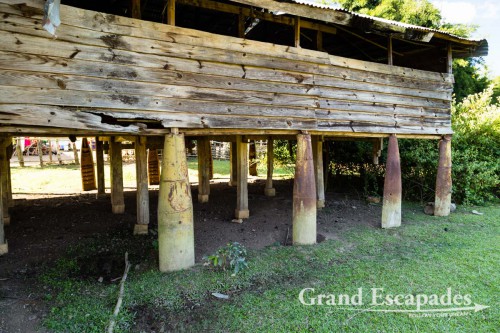UXO stands for “UneXploded Ordnance”. Of the estimated 2 million tons of bombs, including 280 million cluster bombs dropped onto Laos between 1964 and 1973, about 30% did not explode! These have killed no less than 14.000 people in Laos in the last 30 years and crippled 44.000. The province of Xinuang Khoung, with its capital Phonsavanh, was especially targeted during the bombing raids. The USA suspected this northeastern province to be the hiding place of the communist Pathet Lao.
Even though the Geneva Convention declared Laos a neutral country in 1962, this rural peaceful countryside gained the sad reputation of being the most heavily bombed area on this planet during the following decade. Even five years into the bombing, top US politicians, including President Nixon, would deny any knowledge of this massacre on civilians, since the American Congress never officially approved it. Hence the name “Secret War”…
More bombs were dropped in those 580.000 deadly missions led by the US Air Force on Laos than on Germany and Japan together during World War II. Being a “Secret War”, data on the amount of bombs dropped is incomplete, but 1.36 million metric tons of bombs were acknowledged by the USA in 1994. Two million metric tons of bombs are considered a serious estimate, since some data are still missing.
Two aspects made this bombing campaign especially lethal for the civil population. First, since it was no official war, there were no rules of engagement, like in Vietnam, were temples and the civil population theoretically were protected. It was just “bombing as you wish”, targeting a purely civilian population that had nowhere to hide, except a few caves. However, even these became targets. At Tham Piu Cave, 374 people, mainly women and children who had sought shelter from the bombing were killed instantly, when, on the fourth attempt by American planes, a rocket found its way inside.
Secondly, the vast majority of the bombs used were cluster bombs. These are heavy bombs, generally 1.000 or 2.000 pounds, which open mid-air and release up to 670 sub munitions also called “Bombies” in Laos. It is estimated that up to 30% of the approx. 280 million “Bombies” that were dropped never exploded, creating a huge threat for generations to come.
During and immediately after the war, the lack of food was equally dramatic: with so many “Bombies” littering the ground, a huge part of the cultivable areas could no longer be used, so it became impossible to grow sufficient food. Especially the work in the rice fields turned deadly. But any kind of work, like building a house, could be lethal, not talking about the many “Bombies” found by children who had now idea what it was and and mistook it for a toy.
The Mine Advisory Group or M.A.G. started working in Laos in 1994, 20 years after the end of the “Secret War”. M.A.G. is a British association that is committed to clearing areas of mines and bombs. Even though great progress has been made, they “only” find and destroy 100.000 “Bombies” per year: at that pace, it will take almost 1.000 years to get rid of all the “Bombies” that have killed so many civilians.
The main activity and commitment of M.A.G. is the training of local technicians, both men and women. Teams are trained to remove a specific type of ordnance, for instance “Bombies”. Others specialize in eliminating “big bombs”, some weighing up to 2.000 pounds. Such technicians, who risk their life on a daily basis, are paid 55 USD a week.
There are of course other Associations working currently on clearing areas from bombs & mines in Laos. At the time of our trip in November 2014, more than 50 teams of 12 people (14 of them from M.A.G.) each were working only in the province of Xinuang Khoung. When visiting the Plain of Jars, we could hear UXOs being destroyed every now and then…
Although most accidents happen when people are tending their fields or building new houses, a considerable number of people got killed when they tried to dismantle bombs. The fact that a kilo of scrap metal sells for 0.15 USD and gunpowder twice as much makes this a very tempting business in poor rural areas. Many villagers, especially children, roam the countryside looking for metal with the help of cheap metal detectors. These can be bought for 12 USD at the omnipresent Chinese markets in Laos. “Bombies” are very different to landmines, the latter are designed to maim, but “Bombies” are meant to kill.
Apart from training technicians, M.A.G. also runs educational campaigns in the villages, especially aimed at young children. Particularly young boys are tempted to prove their courage… But M.A.G. also does a great job informing a wider range of people. Every evening, three excellent DVDs can be watched free of charge in their small office in Phonsavanh. These inform about the work and training of M.A.G. personnel and also provide gripping footage of the “Secret War”, interviews with American politicians, pilots praying before starting on a bombing mission and media coverage from that time. Especially touching are the interviews with a few villagers who survived the horror and tell about the hunger, constant attacks and the many family members they lost.
A rather bizarre side of the aftermath of the bombardments is the so-called “war scrape architecture”. This term was coined to describe the use of empty bomb shells and Bombies in every practical manner. Some of the stilt houses rest on four upright bomb casings, rather than wooden pillars. Half a bomb shell may serve to grow a little herb garden. We have seen an entire fence made of big shells, a bomb shell dangling from pole as a bell and smaller “Bombies” that were used as candle holders.
It is not often that you run across these bizarre reminders of the war, because, as mentioned before, metal is a precious thing.





No comments yet.